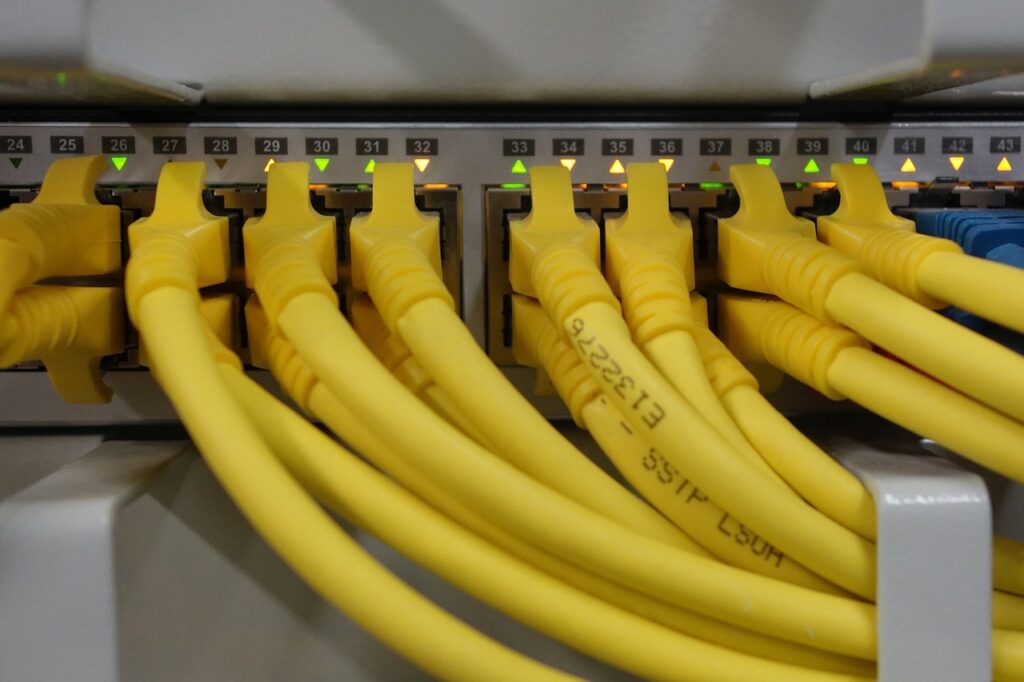Wireless Principles in Networking
Wireless principles form the foundation of modern communication networks, enabling the seamless transmission of data over the airwaves. From the utilization of non-overlapping Wi-Fi channels to the implementation of encryption protocols, each aspect plays a crucial role in ensuring the efficiency, security, and reliability of wireless communication systems. In this comprehensive exploration, we will delve into these wireless principles, covering non-overlapping Wi-Fi channels, SSID, RF (Radio Frequency), and encryption in detail.

Non-overlapping Wi-Fi Channels:
The concept of non-overlapping Wi-Fi channels is critical for optimizing network performance in areas with high wireless activity. By strategically assigning access points and devices to these channels, network administrators can minimize interference and maximize throughput. Additionally, understanding non-overlapping channels is essential for troubleshooting and diagnosing connectivity issues in Wi-Fi networks.
When setting up a Wi-Fi network, it is important to use non-overlapping channels to reduce interference and ensure optimal performance. Wi-Fi operates in the 2.4 GHz and 5 GHz frequency bands, and each band has its own set of channels.
2.4 GHz Band
In the 2.4 GHz band, channels are spaced 5 MHz apart, but each channel is 20 MHz wide. This overlap can cause interference if adjacent channels are used simultaneously. To avoid this, only three non-overlapping channels are typically recommended:
- Channel 1 (center frequency 2.412 GHz)
- Channel 6 (center frequency 2.437 GHz)
- Channel 11 (center frequency 2.462 GHz)
Using these three channels minimizes interference because there is sufficient separation between them.
5 GHz Band
The 5 GHz band has many more channels and a wider frequency range, allowing for more non-overlapping channels. Channels in this band are also 20 MHz wide, but because the available spectrum is larger, there is less risk of overlap. Here are some of the non-overlapping channels typically used:
- 20 MHz Channels: Channels such as 36, 40, 44, 48, 149, 153, 157, and 161 are non-overlapping.
- 40 MHz Channels: When using 40 MHz wide channels, combining pairs such as (36+40), (44+48), (149+153), and (157+161) results in non-overlapping channels.
- 80 MHz Channels: For 80 MHz wide channels, groups like (36+40+44+48) and (149+153+157+161) can be used without overlapping.
The specific non-overlapping channels available in the 5 GHz band can vary by country due to different regulatory restrictions.
Summary
- 2.4 GHz Band: Use channels 1, 6, and 11 to avoid overlap.
- 5 GHz Band: Utilize the numerous non-overlapping channels available, selecting based on the channel width (20 MHz, 40 MHz, or 80 MHz) and regulatory constraints in your region.
SSID (Service Set Identifier):
An SSID (Service Set Identifier) is a unique identifier that names a wireless local area network (WLAN). It is used to distinguish one network from another and can be thought of as the network’s name. When you connect a device to a Wi-Fi network, the SSID is the name you see in the list of available networks. Here are some key points about SSIDs:
Uniqueness:
Each SSID must be unique within the range of the wireless network to avoid confusion. Multiple networks can have the same SSID, but it can cause issues with connectivity and network management.
Length:
An SSID can be up to 32 characters long. It can include letters, numbers, and special characters.
Broadcasting:
By default, most routers broadcast their SSID, making the network name visible to any device within range. However, broadcasting can be disabled for security purposes, making the network hidden.
Security:
While the SSID itself does not provide security, knowing the SSID is necessary to connect to the network. Network security is primarily managed through encryption protocols like WPA3, WPA2, and WEP, which protect the data transmitted over the network.
Configuration:
The SSID is usually set up when configuring the wireless router. It can be changed at any time through the router’s admin settings.
Multiple SSIDs:
Some advanced routers allow the configuration of multiple SSIDs, each with different settings (e.g., one for guests and one for internal use).
Understanding and correctly configuring the SSID is crucial for maintaining a secure and efficient wireless network.
RF (Radio Frequency):
Radio Frequency (RF) refers to the electromagnetic waves used in various forms of wireless communication. These frequencies are typically in the range of 3 kHz to 300 GHz, encompassing a broad spectrum that includes radio waves, microwaves, and other frequencies used for communication, broadcasting, and signal transmission.
Following are Key Concepts in RF:
Frequency Bands:
- Very Low Frequency (VLF): 3 kHz to 30 kHz
- Low Frequency (LF):30 kHz to 300 kHz
- Medium Frequency (MF): 300 kHz to 3 MHz (includes AM radio)
- High Frequency (HF): 3 MHz to 30 MHz (includes shortwave radio)
- Very High Frequency (VHF): 30 MHz to 300 MHz (includes FM radio, TV channels 2-13)
- Ultra High Frequency (UHF): 300 MHz to 3 GHz (includes TV channels 14 and up, mobile phones, Wi-Fi)
- Super High Frequency (SHF): 3 GHz to 30 GHz (includes satellite communication, radar)
- Extremely High Frequency (EHF): 30 GHz to 300 GHz (includes some radar and communication systems)
Applications:
- Communication: Mobile phones, Wi-Fi, Bluetooth, satellite communication, and two-way radios.
- Broadcasting: AM/FM radio, television.
- Navigation: GPS systems.
- Medical: MRI machines, medical telemetry.
- Industrial: RFID tags, microwave ovens.
Propagation:
- Line-of-Sight (LoS): Higher frequencies (like UHF and above) often require a direct path between the transmitter and receiver.
- Ground Wave: Lower frequencies (like VLF and LF) can follow the curvature of the Earth, allowing long-distance communication.
- Skywave: HF frequencies can be reflected off the ionosphere, enabling long-distance communication beyond the horizon.
Modulation:
- Amplitude Modulation (AM): Varies the amplitude of the carrier wave to encode information.
- Frequency Modulation (FM): Varies the frequency of the carrier wave to encode information.
- Phase Modulation (PM): Varies the phase of the carrier wave to encode information.
Antenna Design:
Antennas are crucial for transmitting and receiving RF signals. Their design depends on the frequency of operation and the application.
- Dipole Antenna: Common for many applications.
- Parabolic Antenna: Used for high-gain applications like satellite communication.
- Yagi-Uda Antenna: Often used for TV reception.
Regulation and Standards:
- RF usage is regulated to avoid interference and ensure efficient spectrum use. Regulatory bodies like the FCC (Federal
Encryption
Wireless encryption is a crucial aspect of securing wireless networks, ensuring that data transmitted over these networks is protected from unauthorized access and eavesdropping. Here’s a comprehensive overview of wireless encryption:
Types of Wireless Encryption
Wired Equivalent Privacy (WEP):
- Overview: WEP is one of the oldest wireless encryption standards, introduced in 1997 as part of the IEEE 802.11 standard.
- Security Level: Weak. WEP has significant vulnerabilities due to flaws in its implementation of the RC4 stream cipher and weak encryption keys.
- Usage: Rarely used today due to its weaknesses and the availability of more secure alternatives.
Wi-Fi Protected Access (WPA):
- Overview: WPA was introduced in 2003 as an interim solution to address the flaws in WEP.
- Security Level: Moderate. WPA uses the TKIP (Temporal Key Integrity Protocol) for encryption, which is more secure than WEP but still has some vulnerabilities.
- Usage: Less common now, as WPA2 has largely replaced it.
Wi-Fi Protected Access II (WPA2):
- Overview: Introduced in 2004, WPA2 is an enhancement of WPA and is based on the IEEE 802.11i standard.
- Security Level: High. WPA2 uses the AES (Advanced Encryption Standard) for encryption, which is significantly more secure than TKIP.
- Usage: Widely used and recommended for most modern networks.
Wi-Fi Protected Access 3 (WPA3):
- Overview: Released in 2018, WPA3 is the latest and most secure wireless encryption standard.
- Security Level: Very High. WPA3 includes stronger encryption with the SAE (Simultaneous Authentication of Equals) handshake, which protects against offline dictionary attacks. It also supports forward secrecy and improved security in public networks.
- Usage: Increasingly adopted, especially in newer devices and networks.
Key Concepts in Wireless Encryption
Encryption Protocols
- TKIP (Temporal Key Integrity Protocol): Used in WPA. It dynamically changes keys as the system is used, making it more secure than the static keys used by WEP.
- AES (Advanced Encryption Standard): Used in WPA2 and WPA3. It’s a symmetric encryption algorithm that provides robust security.
Authentication Mechanisms
- Pre-Shared Key (PSK): Commonly used in home and small office networks. Users enter a passphrase to connect.
- Enterprise Mode (EAP)**: Used in larger networks. It involves a RADIUS server for authentication, providing stronger security through individual user credentials.
Enhanced Features in WPA3
- SAE (Simultaneous Authentication of Equals): Replaces the PSK authentication mechanism, offering more protection against brute-force attacks.
- Forward Secrecy: Ensures that the compromise of one key doesn’t affect the confidentiality of past sessions.
- Individualized Data Encryption: Encrypts data individually between the device and the router, enhancing security in public Wi-Fi networks.
Recommendations for Secure Wireless Networks
- Use WPA3 if Available: For the highest security, use WPA3 encryption. Ensure that both the router and connected devices support WPA3.
- Use WPA2 as a Minimum: If WPA3 is not available, WPA2 with AES encryption is the next best option.
- Avoid WEP and WPA: These older standards are insecure and should be avoided.
- Use Strong Passphrases: Ensure that the Wi-Fi passphrase is complex and not easily guessable.
- Regularly Update Firmware: Keep the router’s firmware up to date to protect against vulnerabilities and exploits.
Wireless encryption is vital for protecting data and maintaining the integrity of wireless networks. As technology evolves, newer standards like WPA3 offer robust security features that address the shortcomings of earlier protocols. By adopting these newer standards and following best practices, users can significantly enhance the security of their wireless networks.
In conclusion, wireless principles encompass a range of concepts and technologies essential for designing, deploying, and securing wireless communication systems. From nonoverlapping Wi-Fi channels to encryption protocols, each aspect plays a crucial role in optimizing performance, ensuring reliability, and protecting sensitive information in wireless networks. By understanding and implementing these principles effectively, organizations can create robust and secure wireless infrastructures to meet the demands of today’s interconnected world.




